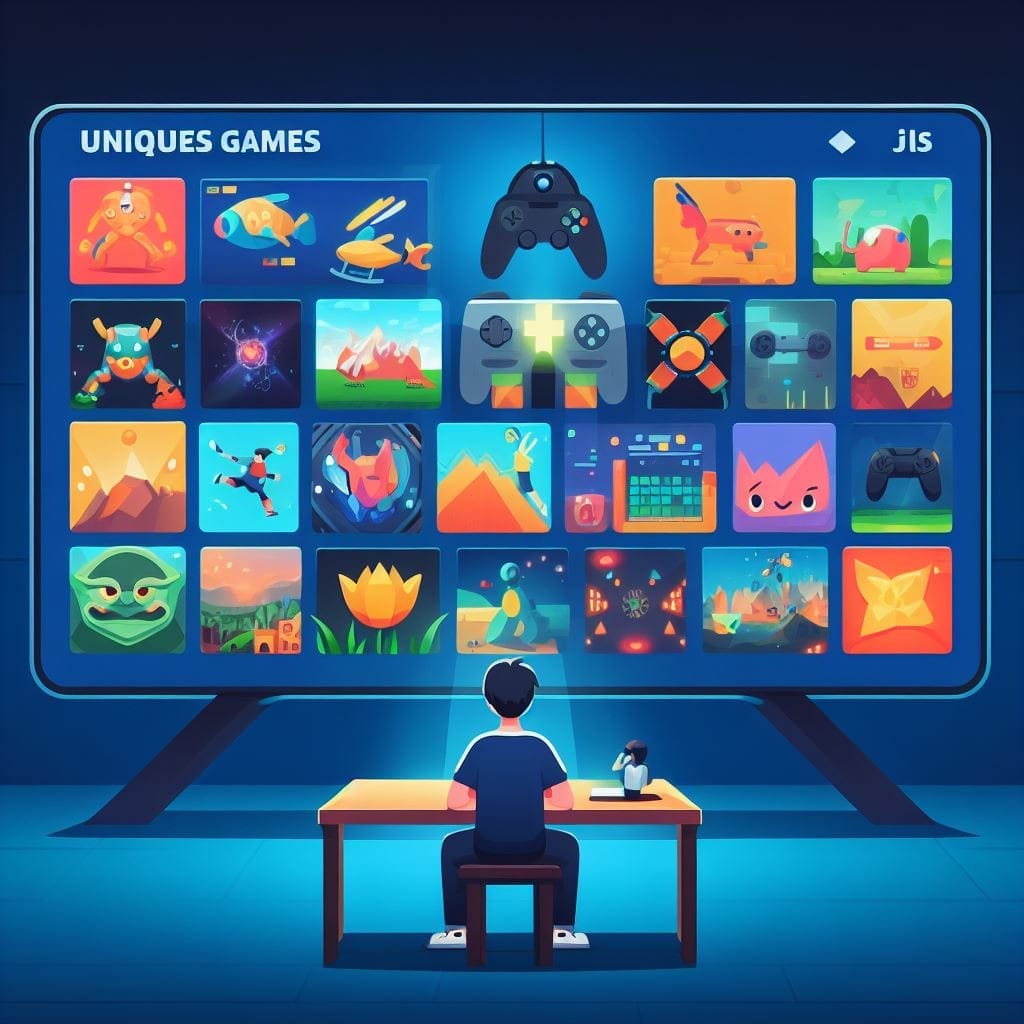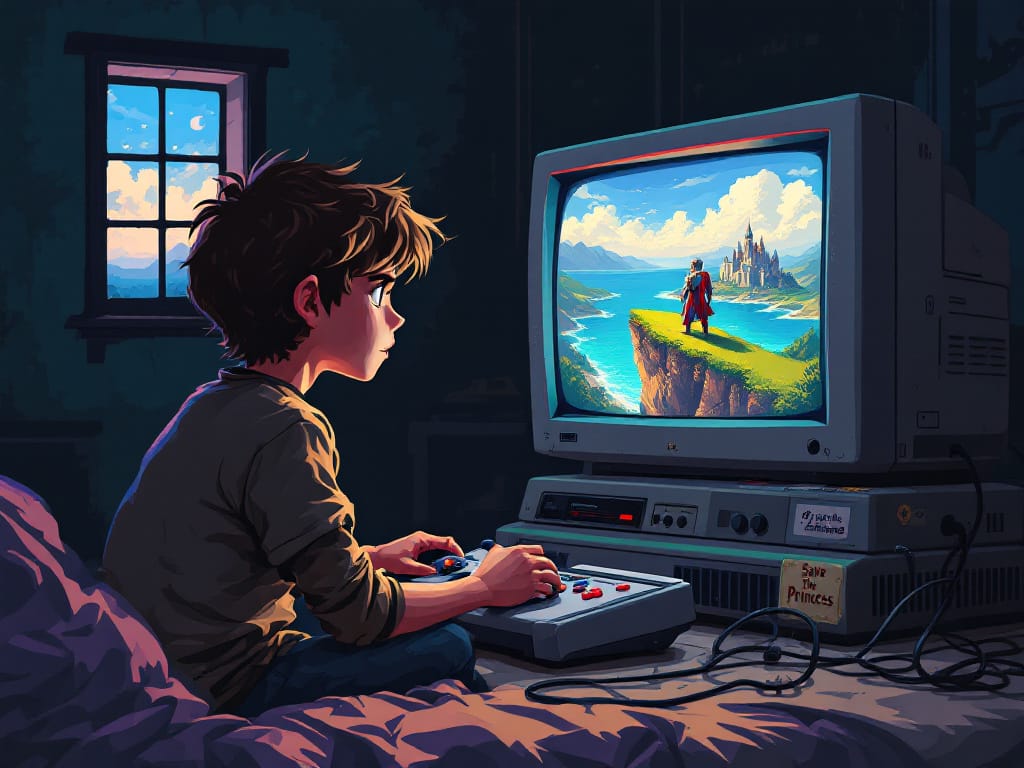Games are a ubiquitous part of human culture. From ancient board games like Chess and Go to modern video games, we seem to have an innate desire to play games. But what makes games fun? In this article, we’ll explore the psychology and neuroscience behind why humans enjoy games.
What Makes Games FUN

Games Allow Us to Learn Without Real-Life Consequences
On a neurological level, having fun releases dopamine in the brain, giving us feelings of pleasure and satisfaction. Thanks to evolution, our brains are wired to enjoy learning new skills or mastering challenges because it improves our chances of survival.
However, learning in games is different than in real life. Games provide a safe environment to learn without anxiety over real consequences. As a result, games can be unpredictable without causing severe stress. In contrast to real life, where actions have consequences, games let us learn freely.
💡Key Takeaway: VideoGames provide a space to learn and achieve without real-life consequences, allowing us to take risks and explore new skills. This freedom taps into our brain’s dopamine reward system for learning new things, making certain games fun while others not.

Fun Declines When Patterns Become Predictable
Humans are natural pattern learners. Our brains constantly look for new data to reinforce known patterns or learn new ones. This pattern recognition system allows us to learn and exist in the world.
When we run out of new things to learn, we tend to get bored. In games, players not only get bored when they’ve learned all available patterns, but also when:
- Game patterns don’t match personal interests
- Patterns seem too simple or too difficult
- Patterns are revealed too slowly or quickly
- Players find ways to cheat the system
💡 Key Takeaway: Games are fun when they teach new, interesting patterns at the right pace. If patterns become too predictable, simple, or mismatched with player interests, fun declines.

Six Helpful Pattern Categories in Games
According to game designer Rlaph Koster, in its book “Theory of Fun”, all patterns in games fit into six categories that have helped humans evolve:
Calculating Odds and Predicting Events
This pattern involves probability, weighing risks versus rewards, and predicting outcomes. Games that use chance force players to make the best decisions under uncertainty. For example, in the classic board game Backgammon, players roll dice and then must choose between different options for moving their pieces based on predicting the likelihood of favorable rolls. The player who can best calculate odds and minimize their risks while capitalizing on opportune rolls will win. This teaches skills around evaluating situations statistically to determine the wisest choices.
Involves probability, prediction, and weighing risks vs. rewards
Example: Backgammon (predicting dice rolls)
Social Status
These patterns relate to moving yourself and others up or down in a social hierarchy to signal value and compete for prestige. Many multiplayer games utilize ladders, rankings, or points to create status competition. For example, in competitive modes of Overwatch, players battle to increase their skill ranking compared to others. Outplaying a rival provides satisfaction from gaining status. People will even trash talk each other based on their ranks. These social status patterns can create validation but also breed toxicity. The drive for status is deeply ingrained in the human psyche, but healthily channeled leads to personal growth.
Pushing yourself and others up/down a hierarchy
Example: Competitive ranking systems
Spatial Reasoning
Spatial reasoning involves analyzing options, envisioning outcomes, and planning sequences of actions. Chess is a classic example, where players must think several turns in advance, considering potential responses to each move. Puzzle games similarly require envisioning patterns and transformations of space over time. Mastering spatial reasoning in games helps develop aptitudes to solve real-world problems involving navigation, construction, mechanics, and more. But it requires diligence to apply game skills outside their original context.
Analyzing options and planning ahead
Example: Chess (thinking moves in advance)
Memory
Memory patterns challenge players to recall and manage information. Card games often rely heavily on memory. For example, competitive Memory masterminds can track every card played in Magic: The Gathering, deducing probabilities to gain an edge. More extreme examples like counting cards in Blackjack push cognitive limits. Memory training transfers to real-world skills like studying, recalling processes, and attention to detail.
Recalling and managing complex information
Example: Card counting in Blackjack
Visceral Responses
These patterns create physical reactions to non-physical stimuli. For example, fast-paced shooters trigger fight or flight physiological responses and release adrenaline, despite the virtual environment posing no real danger. Rhythmic games also tap into visceral sensations through sound, touch, and movement. Exercising visceral response patterns likely helped ancestors survive threats. But excessive stimulation can be addictive. Moderation is key.
- Physical reactions to non-physical stimuli
- Example: Shooters (adrenaline rush)
Teamwork
Teamwork involves coordinating strengths and aligning efforts to achieve shared goals. Multiplayer games let groups combine their skills, whether cooperating against computer opponents or competing against other players. Teamwork teaches effective communication, planning, and collaboration skills. But it also fosters social bonds and a sense of belonging. Friendships built cooperating in games often extend beyond virtual worlds into positive real-life relationships.
Working together to achieve goals
Example: Multiplayer games
These universally helpful skills likely contributed to human survival. Matching game patterns to these categories taps into our natural interests.
💡 Key Takeaway: Games teach patterns that fit into categories humans have evolved to be good at: calculating odds, social status, spatial reasoning, memory, visceral responses, and teamwork. These build helpful real-world skills.

Competitive Games Provide an Endless Challenge in the gaming world
The “holy grail” of game design is a game that:
Provides endless novelty
Requires diverse skills
Adjusts difficulty to player skill perfectly
This is why many games with lasting popularity are competitive multiplayer games. Opponents provide infinite challenges and difficulty levels.
However, not every competitive game succeeds. Most games only slightly improve on competitors by copying mechanics. Truly innovative games combine mechanics in new ways to teach fresh patterns.
💡Key Takeaway: Well-designed competitive games continue being fun by providing endless novelty through real human opponents. This pushes players to continuously improve their skills.
Match Game Personality to Player Preferences
It’s impossible for one game to appeal universally due to the variation in individual strengths, interests, and motivations. However, designers use various techniques to match game personalities and patterns to resonate with their target audience:
Roleplaying Games
RPGs like Final Fantasy appeal to players who enjoy developing complex characters over time through gaining experience, collecting gear, learning skills, and unlocking abilities. The steady sense of growth and customization scratches an itch for progress and ownership.
Exercise Games
Games like Just Dance that get people moving appeal to energetic players looking to actively break a sweat. The physical exertion provides a rush unavailable in sedentary games. This helps extroverted or athletic players engage with games in a way suited to their temperament.
Puzzle Games
Puzzle games like Portal attract players who enjoy spatial reasoning challenges. Evaluating patterns and permutations to solve novel problems provides satisfying stimulation for logical thinkers. Puzzles flex mental muscles in a way action-oriented games do not.
Creation Games
Sandbox create-your-own games like Minecraft appeal to artistic players who want to build, design, and create freely. By providing tools for freeform expression, these games satisfy a need for creativity missing in tightly structured games.
Social Games
Multiplayer focused games like Among Us attract social butterflies who want to interact and compete with other people. The human element enhances engagement for extroverted players.
Text-Based Games
Some players appreciate combat systems and puzzles based primarily on text descriptions, stats, and imagination rather than flashy graphics. Text-based RPGs appeal to bookworms who want to roleplay in interactive stories.
Theme/Genre Appeal
Certain themes or genres resonate more with some personalities. War history buffs may especially enjoy real-time strategy games set in eras like WWII. Horror fans gravitate toward scary games. Licensed IPs can also draw established fans of that franchise’s characters and settings. As an example Fighting games.
Overall, aligning game personalities with player interests through these kinds of tailored experiences increases motivation to engage. Players want to feel “seen” through personalized game design.
💡Key Takeaway: Carefully matching game personalities and patterns to natural player preferences allows designers to appeal to their target audience.

Focus on the Core Gameplay First
Many games feature expansive fictional worlds and characters. However, the metaphors are often secondary to the underlying gameplay patterns.
The best test of a game’s fun is stripping away all graphics, music, and narrative elements and playing the bare mechanics. If the core gameplay loop is fun, added content will enhance enjoyment. But no amount of ancillary features can make a boring game fun.
💡Key Takeaway: For a fun game, the underlying gameplay mechanics must be enjoyable even without supplemental narrative and audiovisual elements. These features should complement already fun mechanics.
Strong Feedback Loops Amp Up Engagement
Beyond just being learnable and novel, games need strong feedback loops to create ongoing engagement. Feedback gives players immediate responses to their actions, reinforcing lessons learned.
Two key types of feedback in games are:
- Quantitative feedback provides numerical trackers clearly indicating progress like scores, levels, or resources. Watching these metrics increase is satisfying.
- Qualitative feedback includes aesthetics like animations, sounds, and visual effects responding to player actions. These make abilities feel impactful.
Good feedback celebrates player success while minimizing negative feelings from failure. Short and long-term goals with clear progress indicators keep players striving for more.
💡Key Takeaway. Effective feedback mechanisms like scores, visual effects, and audio celebrate player success. This creates compulsive engagement loops that minimize frustration.
Four Types of Fun
Psychologist Nicole Lazzaro identified four types of fun players experience in games:
- Easy Fun – Enjoyment from familiar experiences and unwinding
- Hard Fun – Struggle and triumph over challenges
- People Fun – Bonding and competing with others
- Serious Fun – Finding meaning and personal development
Great games incorporate all four types of fun in moderation. This keeps players engaged through a variety of emotions and social connections.
💡 Key Takeaway: Balancing different types of fun including relaxation, challenge, socializing, and meaning allows games to appeal to a broad spectrum of human motivations and emotions.
Multiplayer Games Must Minimize Toxicity
Competition tends to bring out the worst in some people. Many gamers exhibit toxic behavior like harassment, cheating, and poor sportsmanship. This pushes away other players and ruins the experience.
Designers use features like reputation systems, bans, and chat moderation to minimize toxicity. But prevention is ideal through promoting good conduct and meaningful social connections.
Shared cooperative challenges instead of zero-sum competition also reduce negative behavior. Prioritizing healthy social motivations makes winning and losing less important.
💡Key Takeaway: Toxic behavior from overly competitive players can undermine multiplayer games. Smart design minimizes this by facilitating positive social interactions and cooperative goals over raw competition.

Case Study: World of Warcraft
The massively multiplayer RPG World of Warcraft has stayed popular since launching in 2004. Several design factors contribute to its enduring and broad appeal:
Breadth of content – Huge world with quests, dungeons, battles, professions, etc. Provides endless novelty.
Progression system – Clear character advancement path with regular upgrades and goals. Strong feedback.
Social ecosystem – Group play fosters friendships and bonds between players.
Balanced challenge – Scalable difficulty for casual and hardcore players. Hard fun for all.
Personal expression – Customizable characters and structures allow creative play.
These smart design decisions tap into multiple motivations and deliver endless engagement.
The Future of Fun for every gamer
Advancing technology will enable even more immersive and interactive games. Important innovations to improve engagement include:
- VR/AR – Fully simulated environments tapping into visceral reactions.
- Procedural content – Algorithmically generated endless unique content.
- AI – Adaptive systems reacting to players to provide escalating challenges.
- BCI – Direct neural interfaces allow control with thoughts alone.
As games evolve, designing for maximum engagement while also promoting psychological health will be an increasing focus.
💡 Key Takeaway: Emerging technologies like VR/AR, procedural content, AI, and BCI will enable deeper immersion and adaptivity. This allows endless novelty tailored perfectly to each player.

The Risk of Gaming Addiction
While games can provide fulfilling engagement, there is also the risk of unhealthy overuse. Some players, especially children, may have trouble self-regulating and fall into gaming addiction.
Signs of addiction include inability to cut back despite negative consequences, lying about use, irritability when not playing, neglecting other activities, and continued overuse despite harming relationships or mental health.
Unfortunately, many games are intentionally designed to be as habit-forming as possible. Tactics include:
- Highly variable rewards and random loot drops to trigger compulsive dopamine hits
- Funneling players through finely tuned cores loops full of feedback and upgrades
- Time-limited events and daily rewards to drive daily engagement
- Social pressure and guilt from letting teammates down
While these can make games extremely sticky and profitable, they can also foster unhealthy compulsions. Children and adults with certain behavioral propensities may be at higher risk.
The Responsibility of Game Designers
Game designers have an ethical responsibility to consider the well-being of players, not just sales. Steps designers can take include:
- Allowing players to cap or disable daily play limits and notifications
- Making core games fully enjoyable with minimal grind or monetization pressure
- Focusing progression on skill growth rather than coercive carrots
- Making conversations and cooperation central over isolationism
- Promoting positive social comparison over leaderboards fueling jealousy
- Allowing players to disable harmful social comparison features
- Providing extensive parental control options
With conscientious design focused on fulfillment over addiction, games can bring joy rather than harm. Moderation and self-awareness are always key. Butcompanies and designers should uphold their duty of care to players, many of whom struggle with self-regulation. Society depends on businesses upholding ethical values, not just profits.
💡Key Takeaway.Game companies and designers have a duty of care to avoid exploiting addictive tendencies. Conscientious design focused on fulfillment over addiction can bring joy rather than harm.
Conclusion What makes a game fun and people continuing to play games
Games tap into innate human drives to learn, progress, socialize, and find meaning. By teaching new interactive patterns, providing escalating challenges, and minimizing frustration, games become compulsively engaging. Advancing technology will only deepen immersion into virtual worlds, for better or worse. Responsible game design minimizes potential downsides like isolation or addiction. But at their best, well-crafted games provide fulfilling adventures and bring joy to the lives of millions. The future of fun is bright.
If you have liked this article, you can find more related contents to fun in videogames in our blog.

Frequently Asked Questions (FAQ) What makes a game fun?
Q: What is the psychology behind why people play video games?
A: The psychology behind why people play video games is a complex subject that involves various factors such as the desire for challenge, the need for escapism, the enjoyment of social interaction, and the satisfaction of achieving goals within the game.
Q: How does gaming affect human behavior?
A: Gaming can affect human behavior in both positive and negative ways. On the positive side, gaming can enhance cognitive abilities, improve problem-solving skills, and encourage teamwork and cooperation. However, excessive gaming can lead to addiction, neglect of real-life responsibilities, and increase in aggressive behavior.
Q: What are the benefits of playing video games?
A: Playing video games can have several benefits, such as improved hand-eye coordination, enhanced memory and concentration, better multitasking skills, and increased creativity. It can also provide a means of stress relief and relaxation.
Q: Why do people become addicted to gaming?
A: People can become addicted to gaming due to various factors, including the desire for continuous progress and achievements within the game, the sense of escape and immersion provided by gaming, and the social connection and validation received through online gaming communities.
Q: Are certain types of games more likely to cause addiction?
A: Certain types of games, particularly those that involve highly rewarding and repetitive gameplay, such as action games and role-playing games, have been found to be more addictive. Additionally, games that offer in-game purchases or microtransactions can also contribute to addictive behavior.
Q: Can video games lead to violent behavior?
A: While there is a correlation between exposure to violent video games and increased aggression, it is important to note that video games alone do not directly cause violent behavior. Other factors, such as individual predispositions and environmental influences, play a more significant role in determining behavior.
Q: How can game developers create games that are less likely to cause addiction?
A: Game developers can create games that are less likely to cause addiction by implementing features that promote breaks and moderation, such as setting time limits, providing reminders to take breaks, and designing games that encourage a balanced approach to video game play.
Q: Does playing video games have any positive effects on prosocial behavior?
A: Yes, studies have shown that playing video games can have positive effects on prosocial behavior, such as increased empathy, cooperation, and helpfulness towards others. Games that involve teamwork and require players to work together towards a common goal are particularly beneficial in this regard.
Q: Can children become addicted to gaming?
A: Yes, children can become addicted to gaming, just like adults. Children are more vulnerable to gaming addiction due to their developing self-control and susceptibility to external influences. It is important for parents and caregivers to monitor and regulate their children’s gaming habits.
Q: How can gaming addiction be treated?
A: Gaming addiction can be treated through various approaches, including cognitive-behavioral therapy, family therapy, and the establishment of healthy coping mechanisms. It is important to address underlying issues and provide support to individuals struggling with gaming addiction.






















